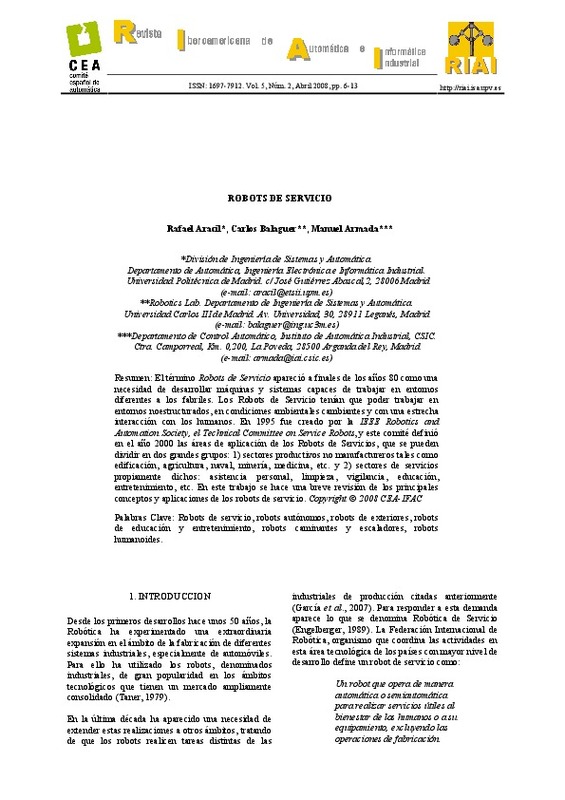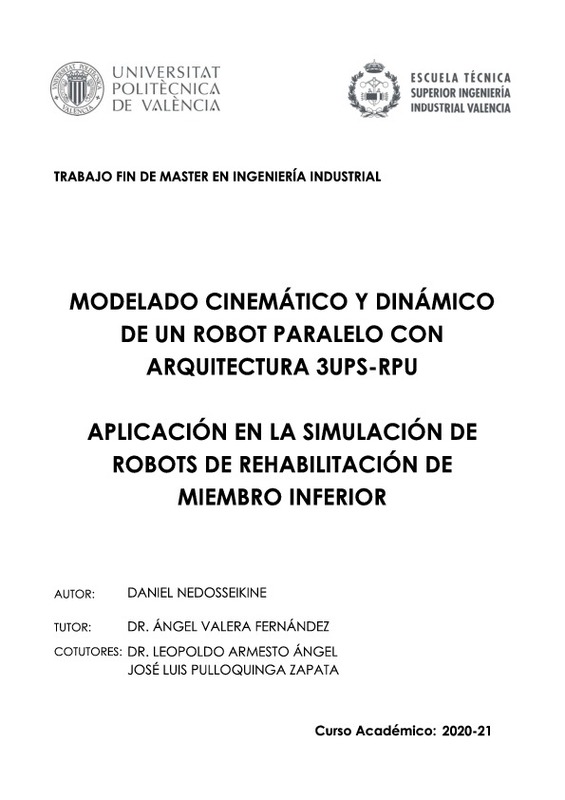JavaScript is disabled for your browser. Some features of this site may not work without it.
Buscar en RiuNet
Listar
Mi cuenta
Estadísticas
Ayuda RiuNet
Admin. UPV
Cinemática de un manipulador configurable por medio de la teoría de tornillos
Mostrar el registro sencillo del ítem
Ficheros en el ítem
| dc.contributor.author | Gallardo-Alvarado, J.
|
es_ES |
| dc.contributor.author | Tinajero-Campo, J. H.
|
es_ES |
| dc.contributor.author | Sánchez-Rodríguez, Á.
|
es_ES |
| dc.date.accessioned | 2021-02-03T08:03:34Z | |
| dc.date.available | 2021-02-03T08:03:34Z | |
| dc.date.issued | 2020-12-23 | |
| dc.identifier.issn | 1697-7912 | |
| dc.identifier.uri | http://hdl.handle.net/10251/160619 | |
| dc.description.abstract | [EN] This paper addresses the kinematic analysis of a redundant parallel manipulator with a configurable platform equipped with two end-effectors. The closure equations of the position analysis generate a system of quadratic equations which is solved by applying the Newton-homotopy method. Subsequently, the instantaneous kinematics of the robot is solved by resorting to the theory of screws. The efficiency of the method is such that the calculation of passive joint rates of the robot is not required form the determination of the input-outputn equation of velocity of the parallel manipulator. Numerical examples are compared with the outcome of a commercial software demonstrating the approach correctness. | es_ES |
| dc.description.abstract | [ES] En este trabajo se aborda el análisis cinemático de un m manipulador redundante con una plataforma configurable equipada con dos efectores finales. Las ecuaciones de clausura del análisis de posición generan un sistema de ecuaciones cuadráticas el cual se resuelve aplicando Newton-homotopía. Posteriormente, la cinemática instantánea del robot se resuelve recurriendo a la teoría de tornillos. La eficiencia del método es tal que no se requiere del cálculo de las velocidades articulares pasivas del robot para la determinación de la ecuación entrada-salida de velocidad del manipulador paralelo. Ejemplos numéricos se comparan con los resultados de un software comercial lo cual demuestra veracidad del método. | es_ES |
| dc.description.sponsorship | Este trabajo ha sido realizado gracias al apoyo del Consejo Nacional de Ciencia y Tecnología de México, Conacyt, a través de la membresía del Dr. Jaime Gallardo–Alvarado al Sistema Nacional de Investigadores. | es_ES |
| dc.language | Español | es_ES |
| dc.publisher | Universitat Politècnica de València | es_ES |
| dc.relation.ispartof | Revista Iberoamericana de Automática e Informática industrial | es_ES |
| dc.rights | Reconocimiento - No comercial - Compartir igual (by-nc-sa) | es_ES |
| dc.subject | Industrial robotics and robotic manipulators | es_ES |
| dc.subject | Multibody systems | es_ES |
| dc.subject | Robot kinematics | es_ES |
| dc.subject | Robotic systems | es_ES |
| dc.subject | Cinemática de robots | es_ES |
| dc.subject | Robot industrial y manipuladores robóticos | es_ES |
| dc.subject | Sistemas multicuerpo | es_ES |
| dc.subject | Sistemas robotizados | es_ES |
| dc.title | Cinemática de un manipulador configurable por medio de la teoría de tornillos | es_ES |
| dc.title.alternative | Kinematic of a configurable manipulator using screw theory | es_ES |
| dc.type | Artículo | es_ES |
| dc.identifier.doi | 10.4995/riai.2020.12793 | |
| dc.rights.accessRights | Abierto | es_ES |
| dc.description.bibliographicCitation | Gallardo-Alvarado, J.; Tinajero-Campo, JH.; Sánchez-Rodríguez, Á. (2020). Cinemática de un manipulador configurable por medio de la teoría de tornillos. Revista Iberoamericana de Automática e Informática industrial. 18(1):58-67. https://doi.org/10.4995/riai.2020.12793 | es_ES |
| dc.description.accrualMethod | OJS | es_ES |
| dc.relation.publisherversion | https://doi.org/10.4995/riai.2020.12793 | es_ES |
| dc.description.upvformatpinicio | 58 | es_ES |
| dc.description.upvformatpfin | 67 | es_ES |
| dc.type.version | info:eu-repo/semantics/publishedVersion | es_ES |
| dc.description.volume | 18 | es_ES |
| dc.description.issue | 1 | es_ES |
| dc.identifier.eissn | 1697-7920 | |
| dc.relation.pasarela | OJS\12793 | es_ES |
| dc.description.references | Aimedee, F., Gogu, G., Dai, J. S., Bouzgarrou, C., Bouton, N., 2016. Systematization of morphing in reconfigurable mechanisms. Mechanism and Machine Theory 96, 215-224. https://doi.org/10.1016/j.mechmachtheory.2015.07.009 | es_ES |
| dc.description.references | Baron, N., Philippides, A., Rojas, N., 2018. A novel kinematically redundant planar parallel robot manipulator with full rotatability. ASME Journal of Mechanisms and Robotics 11, 1-8. https://doi.org/10.1115/1.4041698 | es_ES |
| dc.description.references | Bonev, I. A., Zlatanov, D., Gosselin, C. M., 2001. Singularity analysis of 3- dof planar parallel mechanisms via screw theory. ASME Journal of Mechanical Design 125, 573-581. https://doi.org/10.1115/1.1582878 | es_ES |
| dc.description.references | Carbonari, L., Callegari, M., Palmieri, G., Palpacelli, M. C., 2014. A new class of reconfigurable parallel kinematic machines. Mechanism and Machine Theory 79, 173-183. https://doi.org/10.1016/j.mechmachtheory.2014.04.011 | es_ES |
| dc.description.references | Chakarov, D., 2004. Study of the antagonistic stiffness of parallel manipulators with actuation redundancy. Mechanism and Machine Theory 39, 583- 601. https://doi.org/10.1016/j.mechmachtheory.2003.12.001 | es_ES |
| dc.description.references | Dai, J. S., Gogu, G., 2016. Special issue on reconfigurable mechanisms: morphing, metamorphosis and reconfiguration through constraint variations and reconfigurable joints. Mechanism and Machine Theory 96, 213-214. https://doi.org/10.1016/j.mechmachtheory.2015.11.006 | es_ES |
| dc.description.references | Fang, H., Tang, T., Zhang, J., 2019. Kinematic analysis and comparison of a 2r1t redundantly actuated parallel manipulator and its non-redundantly actuated forms. Mechanism and Machine Theory 142, 1-23. https://doi.org/10.1016/j.mechmachtheory.2019.103587 | es_ES |
| dc.description.references | Gallardo-Alvarado, J., 2016. Kinematic Analysis of Parallel Manipulators by Algebraic Screw Theory. Springer International Publishing Switzerland, Switzerland. https://doi.org/10.1007/978-3-319-31126-5 | es_ES |
| dc.description.references | Gallardo-Alvarado, J., Rico-Martínez, J. M., 1998. Screw theory and helicoidal fields. Proceedings of the ASME 1998 Design Engineering Technical Conferences, ASME, cD rom. | es_ES |
| dc.description.references | Gallardo-Alvarado, J., Rico-Martínez, J. M., 2001. Jerk influence coefficients, via screw theory, of closed chains. Meccanica 36, 213-228. https://doi.org/10.1023/A:1013074907533 | es_ES |
| dc.description.references | Gallardo-Alvarado, J., Tinajero-Campos, J. H., 2019. A parallel manipulator with planar configurable platform and three end-effectors. Mathematical Problems in Engineering Paper 7972837. https://doi.org/10.1155/2019/7972837 | es_ES |
| dc.description.references | Hoevenaars, A. G. L., Gosselin, C., Lambert, P., Herder, J. L., 2017. A systematic approach for the jacobian analysis of parallel manipulators with two end-effectors. Mechanism and Machine Theory 109, 171-194. https://doi.org/10.1016/j.mechmachtheory.2016.10.022 | es_ES |
| dc.description.references | Kang, X., Dai, J. S., 2019. Relevance and transferability for parallel mechanisms with reconfigurable platforms. ASME Journal of Mechanisms and Robotics 11, 031012 (9 pages). https://doi.org/10.1115/1.4042629 | es_ES |
| dc.description.references | Kock, S., Schumacher, W., 1998. A parallel x-y manipulator with actuation redundancy for high-speed and active-stiffness applications. IEEE International Conference on Robotics and Automation, IEEE, Leuven, pp. 2295- 2300. | es_ES |
| dc.description.references | Kock, S., Schumacher, W., 2000. A mixed elastic and rigid-body dynamic model of an actuation redundant parallel robot with high-reduction gears. IEEE International Conference on Robotics and Automation, IEEE, San Francisco. | es_ES |
| dc.description.references | Lambert, P., Herder, J. L., 2016. Parallel robots with configurable platforms: fundamental aspects of a new class of robotic architectures. Institution of Mechanical Engineers, Part C: Journal of Mechanical Engineering Science 230, 463-472. https://doi.org/10.1177/0954406215602511 | es_ES |
| dc.description.references | Lambert, P., Herder, J. L., 2019. A 7-DOF redundantly actuated parallel haptic device combining 6-DOF manipulation and 1-DOF grasping. Mechanism and Machine Theory 134, 349-364. https://doi.org/10.1016/j.mechmachtheory.2019.01.002 | es_ES |
| dc.description.references | Landure, J., Gosselin, C., 2018. Kinematic analysis of a novel kinematically redundant spherical parallel manipulator. ASME Journal of Mechanisms and Robotics 10, 1-10. https://doi.org/10.1115/1.4038971 | es_ES |
| dc.description.references | Liu, F., Wu, J., Wang, L., Wang, J., 2014. Determination of the maxima singularity-free zone of 4-rrr redundant parallel manipulators and its application on investigating length ratios of links. Robotica 1, 1-17. https://doi.org/10.1017/S0263574714002720 | es_ES |
| dc.description.references | Ma, X., Zhang, K., Dai, J. S., 2018. Novel spherical-planar and bennett- spherical 6r metamorphic linkages with reconfigurable motion branches. Mechanism and Machine Theory 128, 628-647. https://doi.org/10.1016/j.mechmachtheory.2018.05.001 | es_ES |
| dc.description.references | Mohamed, M. G., Gosselin, C., 2005. Design and analysis of kinematically redundant parallel manipulators with configurable platforms. IEEE Transactions on Robotics 21, 277-287. https://doi.org/10.1109/TRO.2004.837234 | es_ES |
| dc.description.references | Mueller, A., 2006. Stiffness control of redundantly actuated parallel manipulators. IEEE International Conference on Robotics and Automation, IEEE, Orlando. | es_ES |
| dc.description.references | Mueller, A., 2008. Redundant actuation of parallel manipulators. In: Wu, H. (Ed.), Parallel Manipulators, Towards New Applications. INTECH. https://doi.org/10.5772/5427 | es_ES |
| dc.description.references | Qu, H., Zhang, C., Guo, S., 2018. Structural synthesis of a class of kinematically redundant parallel manipulators based on modified G-K criterion and RDOF criterion. Mechanism and Machine Theory 130, 47- 70. https://doi.org/10.1016/j.mechmachtheory.2018.08.008 | es_ES |
| dc.description.references | Schreiber, L. T., Gosselin, C., 2018. Kinematically redundant planar parallel mechanisms: Kinematics, workspace and trajectory planning. Mechanism and Machine Theory 119, 91-105. https://doi.org/10.1016/j.mechmachtheory.2017.08.022 | es_ES |
| dc.description.references | Verschelde, J., 1999. Algorithm 795: Phcpack: a general-purpose solver for polynomial systems by homotopy continuation. ACM Transactions on Mathematical Software 25, 251-276. https://doi.org/10.1145/317275.317286 | es_ES |
| dc.description.references | Wu, T.-M., 2005. A study of convergence on the newton-homotopy continuation method. Applied Mathematics and Computation 168, 1169- 174". https://doi.org/10.1016/j.amc.2003.10.068 | es_ES |
| dc.description.references | Wu, T. manipulator -M., 2006. The inverse kinematics problem of spatial 4p3r robot by the homotopy continuation method with an adjustable auxiliary homotopy function. Nonlinear Analysis 64, 2373-2380. https://doi.org/10.1016/j.na.2005.08.021 | es_ES |
| dc.description.references | Ye, W., Fang, Y., Zhang, K., Guo, S., 2014. A new family of reconfigurable parallel mechanisms with diamond kinematotropic chain. Mechanism and Machine Theory 74, 1-9. https://doi.org/10.1016/j.mechmachtheory.2013.11.011 | es_ES |
| dc.description.references | Yi, B.-J., Na, H. Y., Lee, J. H., Hong, Y.-S., Oh, S.-R., Suh, I.-H., Kim, W. K., 2002. Design of a parallel-type gripper mechanism. International Journal of Robotics Research 21, 661-676. https://doi.org/10.1177/027836402322023240 | es_ES |
| dc.description.references | Yi, B. Y., Freeman, R. A., Tesar, D., 1994. Force and stiffness transmision in redundantly actuated mechanisms: the case for a spherical shoulder mechanism. Robotics, Spatial Mechanisma and Mechanical Systems 45, 163-172. | es_ES |
| dc.description.references | Zhang, K., Dai, J. S., Fang, Y., 2013. Geometric constraint and mobility variation of two 3svpsv metamorphic parallel mechanisms. ASME Journal of Mechanical Design 135, paper 011001. https://doi.org/10.1115/1.4007920 | es_ES |











